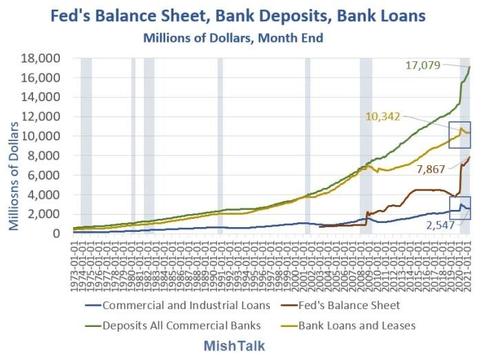Charts That Should Scare The Pants Off The Fed (And Probably Do)
Authored by Mike Shedlock via MishTalk.com,
Let’s investigate the relationship between the Fed’s QE program, bank lending, and alleged stockpiling of cash…
In an effort to stimulate bank lending and thus the economy, the Fed launched a massive QE program that lowered interest rates and crammed money into banks.
Let’s take a look at some numbers.
January 1973 Numbers
-
Commercial and Industrial Loans: $135 Million
-
Fed’s Balance Sheet: $0
-
Bank Deposits: $599 Million
-
Bank Loans and Leases: $405 Million
May 2021 Numbers
-
Commercial and Industrial Loans: $2.547 Trillion
-
Fed’s Balance Sheet: $7.867 Trillion
-
Bank Deposits: $17.079 Trillion
-
Bank Loans and Leases: $10.342 Trillion
Commercial and Industrial Loans, Bank Deposits, Bank Loans and Leases Percent Changes
Year-over-year commercial and industrial loans are down 16.22%, loans and leases are down 4.53%, and deposits are up 11.57%.
The last time year-over-year commercial loans and loans and leases were negative for two consecutive months (as they are now) was August 2010.
However, these are distorted figures.
Notice the big 30% year-over-year spike in commercial and industrial loans in May of 2020. Year-over-year loans and leases also surged 11.12%. Those surges were artificial and related to government programs and guarantees.
The best way of looking at things is a month-by-month take since the beginning of the recession.
Loans, Bank Deposits, and the Fed’s Balance Sheet Details
Since May of 2020, bank loans and leases, and commercial loans have shrunk in a continuous fashion. Both are barely above where they were pre-Covid-19.
Pre-Covid-19 to May of 2021
-
Bank Deposits: +3.7 Trillion
-
Fed’s Balance Sheet: +3.7 trillion
-
Bank Loans and Leases: +0.3 Trillion
-
Commercial and Industrial Loans: +0.2 Trillion
Is this all we get out of expansion of the Fed’s balance sheet by $3.7 trillion, from $13.4 trillion to $17.1 trillion coupled with trillions of dollars of stimulus from Congress?
I am afraid so. And it means businesses just do not want to expand.
Corporations are borrowing, but from the corporate bond market, not banks, and just to have money, not to expand.
Small to mid-sized businesses that depend on banks are not borrowing at all.
What About Jamie Dimon?
Good question. Please recall Jamie Dimon Stockpiles Cash, Thinks Inflation is Here to Stay, Fears PayPal
“If you look at our balance sheet, we have $500 billion in cash, we’ve actually been effectively stockpiling more and more cash waiting for opportunities to invest at higher rates,” Dimon said. “I do expect to see higher rates and more inflation, and we’re prepared for that.”
I commented:
Even if Dimon believes the inflation setup, I do not buy his story as he presents. He could have and should have mentioned the QE aspect as to why banks are sitting on cash.
Stockpiling Cash?
Dimon is not really stockpiling cash. Rather, Banks are So Stuffed With Cash They Tell Companies: No More Deposits
Since March of 2020, the Fed’s balance sheet is up by $3.7 Trillion and bank deposits are also up by $3.7 trillion.
This we call "stockpiling cash" or (Dimon talking trash), take your pick.
Amazingly,
-
The Fed crams trillions of dollars down banks’ throats.
-
Banks tell corporations no more deposits because they are losing money on them. Alternatively banks have to raise capital.
-
So corporations turn to money market funds.
-
The money market funds do not know what to do with the cash either.
-
So the Fed is forced to take a half trillion dollars back.
-
The Fed said this was expected and is working exactly as designed.
Thank You Fed!
Tyler Durden
Tue, 06/15/2021 – 13:17


